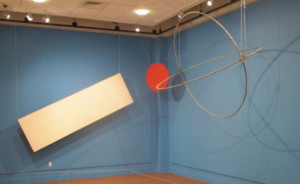 The Ballard Institute and Museum of Puppetry at the University of Connecticut is currently featuring ground-breaking modernist performance sculptures first designed by famed Connecticut sculptor Alexander Calder for the 1936 production of Socrate at Hartford's Wadsworth Atheneum, as part of its current exhibition, American Puppet Modernism: The Early 20th Century, on display Tuesday-Sunday from 11 a.m. to 7 p.m., now through July 1 at the Ballard Institute, located at 1 Royce Circle in Downtown Storrs. The sculptures were reconstructed with Calder's approval for a 1976 performance of Socrate produced by conductor Joel Thome, the director of the Orchestra of Our Time, as part of the National Tribute to Alexander Calder in New York City.
The Ballard Institute and Museum of Puppetry at the University of Connecticut is currently featuring ground-breaking modernist performance sculptures first designed by famed Connecticut sculptor Alexander Calder for the 1936 production of Socrate at Hartford's Wadsworth Atheneum, as part of its current exhibition, American Puppet Modernism: The Early 20th Century, on display Tuesday-Sunday from 11 a.m. to 7 p.m., now through July 1 at the Ballard Institute, located at 1 Royce Circle in Downtown Storrs. The sculptures were reconstructed with Calder's approval for a 1976 performance of Socrate produced by conductor Joel Thome, the director of the Orchestra of Our Time, as part of the National Tribute to Alexander Calder in New York City.
"We are very excited to be able to display these revolutionary examples of avant-garde object performance," said Ballard Institute Director
John Bell. "Alexander Calder is rightly acclaimed as one of the most important American sculptors of the 20th century, but his radical innovations in experimental performance were an important element in Wadsworth Atheneum Director Arthur 'Chick' Austin's visionary efforts to make Hartford an American center of modernist art, theater, dance, and music."
Socrate, composer
Erik Satie's 1919 "symphonic drama in three parts," is based on texts by Plato about the Greek philosopher Socrates, and is written for two voices and a small orchestra. Inspired by the radical puppet and performing object experiments he had witnessed in Paris, and by the possibilities of object performance he had explored with the wire puppets of his miniature Cirque Calder (1926) Alexander Calder designed the three large-scale sculptures to be the central performers his production for Austin's 1936 First Hartford Festival at the Wadsworth Atheneum. "Calder's work in these years is super interesting," Bell said, "because at the same time he is inventing his famous 'mobiles' as stand-alone sculptures, he is also deeply involved in creating moving objects as the centers of attention in live performance." The Ballard Institute installation also features a short documentary video about
Joel Thome's 1976 reconstruction of Socrate.
American Puppet Modernism: The Early 20th Century celebrates the puppet revival that developed across the United States in 1920s and 30s, which mixed traditional European techniques with Asian, African, and Latin American performance; new technologies of film and television; and new commercial and artistic contexts of modern American life. It features work by famed puppeteers such
Tony Sarg, Margo and Rufus Rose, Ralph Chessé, Marjorie Batchelder, Martin and Olga Stevens,
Bil Baird, Frank and Elizabeth Haines, Alexander Calder, the Yale Puppeteers, the Federal Theater Project, and Hazelle Rollins. The Ballard Institute has a suggested donation of $5 per person, but encourages visitors to pay what they wish.
The Ballard Institute & Museum of Puppetry
1 Royce Circle, Suite 101B
Storrs, CT 06268
860-486-8580bimp.uconn.edubimp@uconn.edu
Facebook: Ballard Institute and Museum of Puppetry
Twitter: @BallardPuppetry
Instagram: @ballardinstitute
Comments
To post a comment, you must
register and
login.
![]() The Ballard Institute and Museum of Puppetry at the University of Connecticut is currently featuring ground-breaking modernist performance sculptures first designed by famed Connecticut sculptor Alexander Calder for the 1936 production of Socrate at Hartford's Wadsworth Atheneum, as part of its current exhibition, American Puppet Modernism: The Early 20th Century, on display Tuesday-Sunday from 11 a.m. to 7 p.m., now through July 1 at the Ballard Institute, located at 1 Royce Circle in Downtown Storrs. The sculptures were reconstructed with Calder's approval for a 1976 performance of Socrate produced by conductor Joel Thome, the director of the Orchestra of Our Time, as part of the National Tribute to Alexander Calder in New York City.
The Ballard Institute and Museum of Puppetry at the University of Connecticut is currently featuring ground-breaking modernist performance sculptures first designed by famed Connecticut sculptor Alexander Calder for the 1936 production of Socrate at Hartford's Wadsworth Atheneum, as part of its current exhibition, American Puppet Modernism: The Early 20th Century, on display Tuesday-Sunday from 11 a.m. to 7 p.m., now through July 1 at the Ballard Institute, located at 1 Royce Circle in Downtown Storrs. The sculptures were reconstructed with Calder's approval for a 1976 performance of Socrate produced by conductor Joel Thome, the director of the Orchestra of Our Time, as part of the National Tribute to Alexander Calder in New York City.
